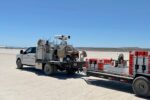Global Positioning System (GPS) has become ubiquitous—and deeply vulnerable. High-profile incidents, including GPS jamming that forced Ursula von der Leyen’s plane to rely on paper maps, sharply highlight the need for alternatives. In response, the U.S. Department of Defense and DARPA’s Robust Quantum Sensors (RoQS) program are developing quantum navigation systems and non-space-based Positioning, Navigation and Timing (PNT) solutions. Meanwhile, industry players like Q-CTRL and startups such as SandboxAQ are pushing forward with quantum-enhanced inertial navigation and AI-driven magnetometry. The future of navigation is shifting off satellites—and onto physics you can’t jam.
1. GPS Is Old, Vulnerable—and Everywhere
For decades, GPS has undergirded global navigation, communications, finance, and logistics. But modern conflict zones—Ukraine, the Baltic, S. China Sea—have exposed glaring weaknesses. GPS is easily jammed, spoofed, or disrupted by adversaries and even space weather. The concerns aren’t academic: civilian systems are already showing degradation, and strategic planners worry about the consequences of a blackout on critical systems.
2. DARPA’s RoQS: Quantum Sensors Get Battle-Ready
To mitigate GPS vulnerabilities, the Pentagon is pursuing alternatives not based in space. DARPA’s Robust Quantum Sensors (RoQS) program is pioneering quantum-based PNT prototypes that function without GPS satellites. At least one contractor—Australia’s Q-CTRL—has received $24.4 million in funding to advance its Ironstone Opal quantum navigation system. The system reportedly delivers a 111× improvement in positioning accuracy over traditional inertial systems under GPS-denied conditions.
This development is more than R&D—it’s strategy: as Vice Chairman Adm. Grady put it, reliance on GPS is increasingly risky, making alternatives a personal and warfighter priority.
3. Beyond Space: A Broader Push for GPS Resilience
The U.S. military isn’t just betting on quantum. A broader shift is underway toward building a layered PNT architecture:
Quantum inertial sensors (e.g. RoQS, Q-CTRL’s Ironstone Opal) deliver self-contained positioning—even under jamming.
AI-enhanced magnetic navigation (SandboxAQ) can tap geomagnetic field mapping as a backup when GNSS is unavailable.
Ground-based PNT systems like eLoran and Locata offer local positioning chains, though many have been shut down or underfunded.
Strategies like celestial navigation, revived from pre-GPS eras, are being kept alive for extreme fallback scenarios.
4. Real-world GPS Failures: The Urgency Is Here
Recent episodes illustrate GPS fragility:
A series of GPS jamming events—likely linked to Russian systems—has disrupted transit in Eastern Europe, even affecting satellites in orbit.
The incident with Ursula von der Leyen’s aircraft highlighted how limited the alternatives remain: pilots had to rely on charts and analog instruments.
Spoofing incidents—from ships mispositioned on land to drones losing track—demonstrate how dangerous reliance on GNSS can be.
Clearly, GPS support is not guaranteed, especially in contested environments.
5. Quantum Navigation: Not Science Fiction
Quantum navigation uses principles of quantum mechanics—like interference patterns and precise inertial measurements—to maintain position even when external signals fail.
DARPA’s RoQS labs are building and testing systems that use this ability under dynamic motion conditions.
Q-CTRL’s Ironstone Opal system—which underwent flight tests—already outperforms high-end INS by over 100× in GPS-denied conditions, maintaining accuracy under g-forces typical of aircraft.
SandboxAQ is using quantum magnetometers and AI algorithms to map and navigate using Earth’s magnetic field—a promising civilian/military complement.
6. Building a Multi-Layered Navigation Architecture
Combining technologies into a resilient PNT system can yield robust alternatives to GPS alone:
| Layer | Technology | Strength |
|---|---|---|
| Primary | GPS / GNSS (e.g. Galileo, BeiDou) | High-precision, global coverage |
| Secondary | Quantum Inertial Systems (RoQS, Ironstone Opal) | Self-contained, jam-resistant |
| Tertiary | AI Magnetometry (SandboxAQ) | Passive, GPS-independent |
| Quaternary | Terrestrial PNT (eLoran, Locata) | Localized, class-approved alternatives |
| Backup | Celestial Navigation | Last-resort for extreme denial environments |
This hierarchy ensures continued navigation—even if one or more layers are compromised.
7. What’s at Stake—and What’s Next
Security implications are profound:
Autonomous systems (drones, missiles) and financial networks rely on GPS timing; disruption cascades rapidly.
Any great-power conflict will likely begin with GPS denial strategies—making successful alternatives not just useful but necessary.
Successful RoQS and quantum-inertial breakthroughs could reshape PNT doctrine across forces—air, land, sea, cyber.









